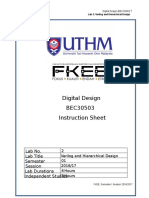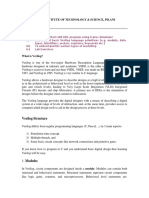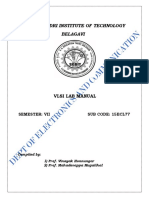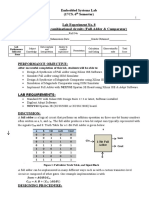Lab 1
Lab 1
Uploaded by
tttm2609Copyright:
Available Formats
Lab 1
Lab 1
Uploaded by
tttm2609Original Description:
Original Title
Copyright
Available Formats
Share this document
Did you find this document useful?
Is this content inappropriate?
Copyright:
Available Formats
Lab 1
Lab 1
Uploaded by
tttm2609Copyright:
Available Formats
Faculty of Computer Science and Engineering Department of Computer Engineering
Ho Chi Minh City University of Technology LOGIC DESGIN WITH HDL
Faculty of Computer Science and Engineering Practical session - Semester 222
WEEK 1
Introduction &
Structural Model
1 Introduction
1.1 Aims
• Get familiar with Vivado software and the FPGA development flow.
• Get familiar with FPGA Arty-Z7 board.
• Practice in designing simple digital logic circuits with Verilog.
• Understand the hierarchical design principle.
• Practice in writing test benches for a designed module.
1.2 Preparation
• Read the laboratory materials before class.
• Revise chapter 0-3 about Verilog basic.
• Each group prepare at least one laptop with Vivado software installed.
1.3 Documents and lab materials
• M. Morris Mano, Michael D. Ciletti, Digital System with an Introduction to the Verilog HDL, VHDL,
and SystemVerilog, Pearson Education, Inc, 2017
• Lecture slides
• Arty-Z7-20-Master.xdc: Arty-Z7 constraint file.
• Guide for Installing Vivado.pdf : Guide for installing Vivado and getting started with Vivado and
Arty-Z7.
• dec1to2.v, mux2to1.v : 2-to-1 multiplexer module and its sub-module.
• mux2to2 tb.v : test bench to simulate the module mux2to1.
1.4 Procedure
For each exercise (also for further labs):
Logic Design with HDL - Semester 222 1/5
Faculty of Computer Science and Engineering Department of Computer Engineering
• Read the requirements, then determine the input/output signals of your circuits.
• Make design idea of the circuit then using Verilog to model the circuit.
• Analysis & Synthesis the circuit with Vivado software.
• Write test bench to simulate the circuit on Vivado Simulator.
• Generate the bitstream and program the Arty-Z7 to evaluate the circuit.
1.5 Report requirements
• Lab exercises will be reviewed directly in class.
• Write report (with circuit/simulation screenshots inserted) in pdf.
• Must have group ID, group member’s names and student IDs in the report.
• Compress the report with code files (only .v files) in only one .zip file, name the .zip the group ID
(for example: Group1.zip).
• Submit on BK-elearning by deadline.
2 Exercises
2.1 Exercise 1
a. Design a 1-to-2 decoder using structure model as the following circuit:
Figure 1: 1-to-2 decoder
b. Design a 2-to-1 multiplexer using structure model and hierarchical design (reuse the module
decoder 1 to 2) as following circuit:
Logic Design with HDL - Semester 222 2/5
Faculty of Computer Science and Engineering Department of Computer Engineering
Figure 2: 2-to-1 multiplexer
Check the schematic in RTL Analysis to see the result circuit.
2.2 Exercise 2
a. Write a test bench for the 2-to-1 Multiplexer in Exercise 1 then use Vivado Simulator to simulate
the design, students can use the given example source code. Let’s analyse the structure of a test bench
then point out the differences between an RTL code and a test bench code.
Change the Radix, Format of signals and use zoom tool to evaluate the waveform.
Check the Tcl console window to see output of $monitor command.
b. Then, perform the Synthesis, compare the Synthesis’s Schematic and the RTL Analysis’s schematic.
c. After that, run the Implementation, check the Utilization report in Project Summary for used
resources.
d. Add the Arty-Z7 constraint file to the project, assign pin for the design as follow:
• in1: btn[0], in2: btn[1]
• sel: sw[0]
• out: led[0]
then, generate bitstream file and program the FPGA to test the implemented circuit on board.
2.3 Exercise 3
a. Design a half-adder circuit using structural model.
Logic Design with HDL - Semester 222 3/5
Faculty of Computer Science and Engineering Department of Computer Engineering
Figure 3: Half adder
b. Design a full-adder circuit using structural model. Reuse the half-adder module.
Figure 4: Full adder
Write a test bench to evaluate operations of the implemented full-adder circuit.
Test the implemented circuit on Arty-Z7 board using switches/buttons and LEDs.
Bonus: show the operands and sum on 7-seg LEDs.
c. Design a 4-bit ripple carry adder using structural model. Reuse the implemented full-adder.
Write a test bench to simulate the implemented circuit.
A3 B3 A2 B2 A1 B1 A0 B0
FA C3 FA C2 FA C1 FA C0
C4 S3 S2 S1 S0
Figure 5: 4-bit ripple carry adder
Logic Design with HDL - Semester 222 4/5
Faculty of Computer Science and Engineering Department of Computer Engineering
2.4 Exercise 4
Give the 2-bit comparator circuit as Figure 6 with A = {A1, A0} and B = {B1, B0} are 2 2-bit input
numbers, A gt B is active if A > B, A lt B is active if A < B and A eq B is active if A = B.
A1 A_gt_B
B1
A0 A_lt_B
B0
A_eq_B
Figure 6: 2-bit comparator
Let’s design a 4-bit comparator following below steps:
• Analyse the functions of each output of the 2-bit comparator, then determine the functions of 4-bit
comparator outputs.
• Conceptualize the design of 4-bit comparator from 2-bit comparators (the 2-bit comparator can be
partitioned into smaller blocks). Draw a block diagram that describes the idea.
• Draw a diagram to shows the designed circuit hierarchy.
• Implement the designed circuit using Verilog HDL structural model.
• Write a test bench to simulate the implemented circuit.
Logic Design with HDL - Semester 222 5/5
You might also like
- Embedded Systems Design - CW1 - First - Sit - 2020 - 2021Document14 pagesEmbedded Systems Design - CW1 - First - Sit - 2020 - 2021rafi ullahNo ratings yet
- Exploring BeagleBone: Tools and Techniques for Building with Embedded LinuxFrom EverandExploring BeagleBone: Tools and Techniques for Building with Embedded LinuxRating: 4 out of 5 stars4/5 (1)
- Lab8 2-Bit Binary Adder-SubtractorDocument11 pagesLab8 2-Bit Binary Adder-SubtractorAhmed Razi UllahNo ratings yet
- Digital Design BEC30503 Instruction Sheet: Lab No. Lab Title Semester Session Lab Durations Independent StudiesDocument30 pagesDigital Design BEC30503 Instruction Sheet: Lab No. Lab Title Semester Session Lab Durations Independent StudiesKarti ViveygenNo ratings yet
- HDL Lab SyllabusDocument2 pagesHDL Lab Syllabussuhas RNo ratings yet
- Vlsi Lab7 F 13 V1Document9 pagesVlsi Lab7 F 13 V1Shannan WeberNo ratings yet
- HDL Lab Manual: Anandanagar, Bangalore-24Document81 pagesHDL Lab Manual: Anandanagar, Bangalore-24Abinet ArbaNo ratings yet
- Verilog LabDocument70 pagesVerilog Labhkes rcrNo ratings yet
- Lab8 2-Bit Binary Adder-SubtractorDocument5 pagesLab8 2-Bit Binary Adder-SubtractorMazoon ButtNo ratings yet
- Lab12 Design of A Combinational Circuit (BCD To 7-Segment Decoder) ND Voting Machine DesignDocument5 pagesLab12 Design of A Combinational Circuit (BCD To 7-Segment Decoder) ND Voting Machine DesignAisha SheikhNo ratings yet
- HDL Manual 2019 5th Sem E&CE 17ECL58Document77 pagesHDL Manual 2019 5th Sem E&CE 17ECL58vishvakirana100% (1)
- Lab 3 (Verilog Implementation of Stop Light Controller)Document7 pagesLab 3 (Verilog Implementation of Stop Light Controller)Muhtasim Fuad JeetNo ratings yet
- DLD Lab Report 07Document11 pagesDLD Lab Report 07Muneeb ahmadNo ratings yet
- Lab Session # 3 Complex Logic Design (Code Converter) : Figure 1: Multi-Input To Multi-Output CircuitDocument10 pagesLab Session # 3 Complex Logic Design (Code Converter) : Figure 1: Multi-Input To Multi-Output CircuitAhmad M. HammadNo ratings yet
- VLSI Lab Manual Student Copy 21-22 04.10.21Document76 pagesVLSI Lab Manual Student Copy 21-22 04.10.21RanjithNo ratings yet
- Ect 203 Logic Circuit Design-Ece - s3 - 2019-Scheme-Syllabus - Ktustudents - inDocument11 pagesEct 203 Logic Circuit Design-Ece - s3 - 2019-Scheme-Syllabus - Ktustudents - indrn86686No ratings yet
- Lab Report FpgaDocument34 pagesLab Report FpgaMuhammad Furqan JavedNo ratings yet
- Digital Design and Computer Organization - BCS302 - LAB MANUALDocument65 pagesDigital Design and Computer Organization - BCS302 - LAB MANUALpadmNo ratings yet
- EN6000 - Project - Oct - 2022 - NewDocument24 pagesEN6000 - Project - Oct - 2022 - News.mahadrNo ratings yet
- ITNPAI1 Assignment S22Document3 pagesITNPAI1 Assignment S22Parisha BhatiaNo ratings yet
- Lab 3 Introduction To VerilogDocument6 pagesLab 3 Introduction To Verilogpioneer boysNo ratings yet
- Department of Biomedical Engineering CSE-221L - Digital Logic DesignDocument8 pagesDepartment of Biomedical Engineering CSE-221L - Digital Logic DesignMUHAMMAD ARSLANNo ratings yet
- LabManual 18ECL58Document60 pagesLabManual 18ECL58back spaceNo ratings yet
- Project DLDDocument3 pagesProject DLDHala QamareldeenNo ratings yet
- Lab12 Voting Machine DesignDocument6 pagesLab12 Voting Machine DesignMuneeb AsifNo ratings yet
- Lab6 BCD-to-Excess-3 Code ConversionDocument6 pagesLab6 BCD-to-Excess-3 Code ConversionMuhammad Asad Khalil RaoNo ratings yet
- FPGA-Based-System-Design LAB JOURNAL 2Document56 pagesFPGA-Based-System-Design LAB JOURNAL 2talha42103No ratings yet
- Lab5 DLDDocument10 pagesLab5 DLDmaria.rehmanNo ratings yet
- Birla Institute of Technology & Science, Pilani Lab Sheet - 1Document7 pagesBirla Institute of Technology & Science, Pilani Lab Sheet - 1SATYAVRAT SHARMANo ratings yet
- DLD-2014 - Practical BookDocument75 pagesDLD-2014 - Practical BookMuhammad Ishtiaq0% (1)
- Vlsi Labmanual Cbcs Scheme 2018Document54 pagesVlsi Labmanual Cbcs Scheme 2018Sanjukumar PukaleNo ratings yet
- CSD Lab Manual v1Document40 pagesCSD Lab Manual v1Shireesh COSindhuNo ratings yet
- Laboratory 2 - 4bits AdderSubtractor - Using Xilinx FPGADocument6 pagesLaboratory 2 - 4bits AdderSubtractor - Using Xilinx FPGAReeseNo ratings yet
- 4 Bit Adder M.P. Join AICTEDocument7 pages4 Bit Adder M.P. Join AICTEVivek SharmaNo ratings yet
- N270L3Document6 pagesN270L3hotfuryNo ratings yet
- Artix7 Verilog Word FileDocument7 pagesArtix7 Verilog Word FileSwapna SarkerNo ratings yet
- Module Instantiation and Test Benches: Hardware Description LanguageDocument15 pagesModule Instantiation and Test Benches: Hardware Description LanguageEnrico RamosNo ratings yet
- DD&CO Full Lab ManualDocument45 pagesDD&CO Full Lab ManualHarshitha SinghNo ratings yet
- Verilog HDL - 18ec56 AssignmentDocument2 pagesVerilog HDL - 18ec56 Assignmentsureshfm1No ratings yet
- Digital Design and Computer Organization - BCS302 - LAB MANUALDocument67 pagesDigital Design and Computer Organization - BCS302 - LAB MANUALZaidaanShiraz50% (6)
- Lab6 BCD-to-Excess-3 Code ConversionDocument7 pagesLab6 BCD-to-Excess-3 Code ConversionMuhammad Asad Khalil RaoNo ratings yet
- Spring 2021: Digital System Design Lab 1Document22 pagesSpring 2021: Digital System Design Lab 1SHAHZAIB AHMAD QURESHINo ratings yet
- Quartus II Tutorial HDLDocument11 pagesQuartus II Tutorial HDLssunil7432No ratings yet
- Pre-Lab1 Digital DesignDocument6 pagesPre-Lab1 Digital DesignGia BaoNo ratings yet
- PDF Lab 2 DLDDocument13 pagesPDF Lab 2 DLDSana KhitranNo ratings yet
- Week 1 Lecture MaterialDocument96 pagesWeek 1 Lecture Materialsaigdv1978No ratings yet
- SKEE1233 Project UTMDocument4 pagesSKEE1233 Project UTMmuhammadridwanjaafarNo ratings yet
- Embedded Systems Lab (17CS. 6 Semester) Lab Experiment No. 8 Designing of Combinational Circuits (Full-Adder & Comparator)Document9 pagesEmbedded Systems Lab (17CS. 6 Semester) Lab Experiment No. 8 Designing of Combinational Circuits (Full-Adder & Comparator)NoorNo ratings yet
- Lab Module 2 SubtractorDocument4 pagesLab Module 2 SubtractorHazim KhadriNo ratings yet
- Index Page: S.No. Date Name of The Experiment Marks Awarded Remarks/ Initial's Part - ADocument39 pagesIndex Page: S.No. Date Name of The Experiment Marks Awarded Remarks/ Initial's Part - ANaveenNo ratings yet
- Lab 9 Excess-3 To Gray Code Conversion Using Nand GatesDocument6 pagesLab 9 Excess-3 To Gray Code Conversion Using Nand GatesZuha FatimaNo ratings yet
- DLDforFall2017 18Document58 pagesDLDforFall2017 18Ramzan AliNo ratings yet
- Lab 6Document15 pagesLab 6taimoor.asad.789No ratings yet
- CE 264 Lab Project: Kuwait UniversityDocument9 pagesCE 264 Lab Project: Kuwait UniversityCalvin SaldanhaNo ratings yet
- Lab 3:-8 Bit AdderDocument13 pagesLab 3:-8 Bit AdderEva TrejosNo ratings yet
- AssignmentDocument9 pagesAssignmentSumit Kumar YadavNo ratings yet
- 17 ECL203 CompressedDocument54 pages17 ECL203 Compressed22051774No ratings yet
- Digi ElectronicsDocument75 pagesDigi ElectronicsLikithaReddy YenumulaNo ratings yet
- 1 2 7 P Understandingdigitaldesign RNG UnfinishedDocument5 pages1 2 7 P Understandingdigitaldesign RNG Unfinishedapi-287488627No ratings yet
- C Programming for the Pc the Mac and the Arduino Microcontroller SystemFrom EverandC Programming for the Pc the Mac and the Arduino Microcontroller SystemNo ratings yet
- Verilog ProjectDocument15 pagesVerilog ProjectKent SardinaNo ratings yet
- New VLSIDocument2 pagesNew VLSIRanjit KumarNo ratings yet
- Vlsi, VHDL and PCB Design: in Electronics and Communication Engineering byDocument45 pagesVlsi, VHDL and PCB Design: in Electronics and Communication Engineering byAbhishek DeyNo ratings yet
- Edit Code - EDA PlaygroundDocument3 pagesEdit Code - EDA PlaygroundjagyanjitNo ratings yet
- VLSI Circuit Design Process-Unit-IIDocument51 pagesVLSI Circuit Design Process-Unit-IICatherineNo ratings yet
- Basic Concept of HDLDocument90 pagesBasic Concept of HDLimoon63No ratings yet
- Introduction To Hardware Description LanguageDocument5 pagesIntroduction To Hardware Description LanguageMallik KglNo ratings yet
- Solution of Verilog HDL by Samir PalnitkarDocument26 pagesSolution of Verilog HDL by Samir PalnitkarMANISH KUMAR67% (3)
- Lab1 Week 1Document52 pagesLab1 Week 1Nguyên Trịnh Vũ ĐăngNo ratings yet
- Shotgun VerificationDocument19 pagesShotgun VerificationMohammad Seemab AslamNo ratings yet
- VHDL 강좌 m10 - 23Document93 pagesVHDL 강좌 m10 - 23rtccNo ratings yet
- Communication SecurityDocument15 pagesCommunication SecurityShahid AzeemNo ratings yet
- DDPP4 TOCwebDocument8 pagesDDPP4 TOCwebravindarsinghNo ratings yet
- Low Power Design Techniques For Digital Logic CircuitsDocument174 pagesLow Power Design Techniques For Digital Logic CircuitsPronadeep BoraNo ratings yet
- Fpga23000 10 WKBF Rev1Document370 pagesFpga23000 10 WKBF Rev1Doravari LakshmiNo ratings yet
- Altera Flex 10Document128 pagesAltera Flex 10swapna2No ratings yet
- FPGA Implementation of Viterbi DecoderDocument6 pagesFPGA Implementation of Viterbi DecoderqsashutoshNo ratings yet
- Verilog For DesignDocument32 pagesVerilog For DesignVidya DilipNo ratings yet
- Testbench Organization and DesignDocument45 pagesTestbench Organization and DesignPham NamNo ratings yet
- Introduction To DDTVDocument62 pagesIntroduction To DDTVWe are youngNo ratings yet
- Verilog Quick Reference CardDocument12 pagesVerilog Quick Reference CardHector CabreraNo ratings yet
- 18EC56 Verilog HDL IntroductionDocument19 pages18EC56 Verilog HDL Introductionece3a MITMNo ratings yet
- Ashish Tiwari: Area of InterestDocument2 pagesAshish Tiwari: Area of InterestVikram ThakurNo ratings yet
- Nand To Tetris: Building A Modern Computer System From First PrinciplesDocument10 pagesNand To Tetris: Building A Modern Computer System From First PrinciplesbatalhagNo ratings yet
- Applied Electronics 05 Ec 64xxDocument60 pagesApplied Electronics 05 Ec 64xxwhiteelephant93No ratings yet
- Als Sda Fpga 01 3s500eDocument30 pagesAls Sda Fpga 01 3s500eVenu Gopal Rao Aggress100% (1)
- Digital Systems Lab ManualDocument63 pagesDigital Systems Lab Manualinfant199218No ratings yet
- Research Paper Topics VlsiDocument7 pagesResearch Paper Topics Vlsihyzypif0gif3100% (1)
- Design and Implementation of Transient Secure Encoder and DecoderDocument3 pagesDesign and Implementation of Transient Secure Encoder and DecoderInternational Journal of Innovative Science and Research TechnologyNo ratings yet
- AXI To AHB-Lite Bridge Cycle ModelDocument22 pagesAXI To AHB-Lite Bridge Cycle ModelavshaeNo ratings yet

























































































